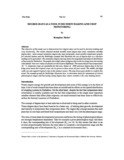Please use this identifier to cite or link to this item:
https://cris.library.msu.ac.zw//handle/11408/560| Title: | Degree-days as a tool in decision making and crop monitoring | Authors: | Shoko, Kampion | Keywords: | Decision making Crop monitoring |
Issue Date: | 2006 | Publisher: | Midlands State University | Series/Report no.: | The Dyke;Vol.2;No.2.2 p. 15-32 | Abstract: | The objective of this study was to demonstrate how degree-days can be used in decision making and crop monitoring. The results obtained include monthly mean degree-days total, cumulative monthly degree-days , mean annual cumulative degree-day map and graphs, mean monthly temperature graphs for selected stations and the Beitbridge example that illustrates the use of degree-days as a decision making tool in agriculture. The cumulative degree-day map shows the magnitude and temporal distribution of heat units for Zimbabwe. The graphs show high values of degree-days in the low lying areas decreasing with altitude. Near zero values are found over the Eastern Highlands. This means that for base temperature 18 ° C, temperate crops are unsuitable for this area. Values of 2000 and more degree-days in the low lying areas mean that tropical crops can be grown in these areas all year round. The middle and high velds can only support tropical crops in the summer season. The map drawn goes further to confirm this trend. The example graph for Beitbridge illustrates how to determine dates for attainment of critical phenological stages and harvesting using degree-days where warmth is the only limiting factor. | URI: | http://hdl.handle.net/11408/560 | ISSN: | 1815-9036 |
| Appears in Collections: | Research Papers |
Show full item record
Page view(s)
148
checked on Dec 15, 2025
Download(s)
42
checked on Dec 15, 2025
Google ScholarTM
Check
Items in MSUIR are protected by copyright, with all rights reserved, unless otherwise indicated.




